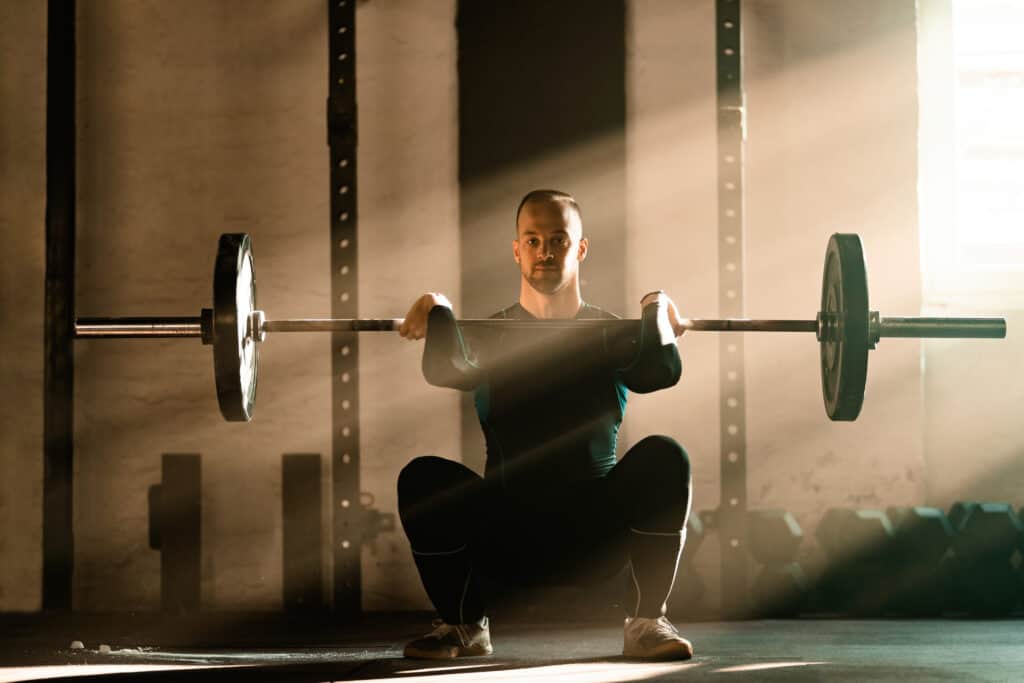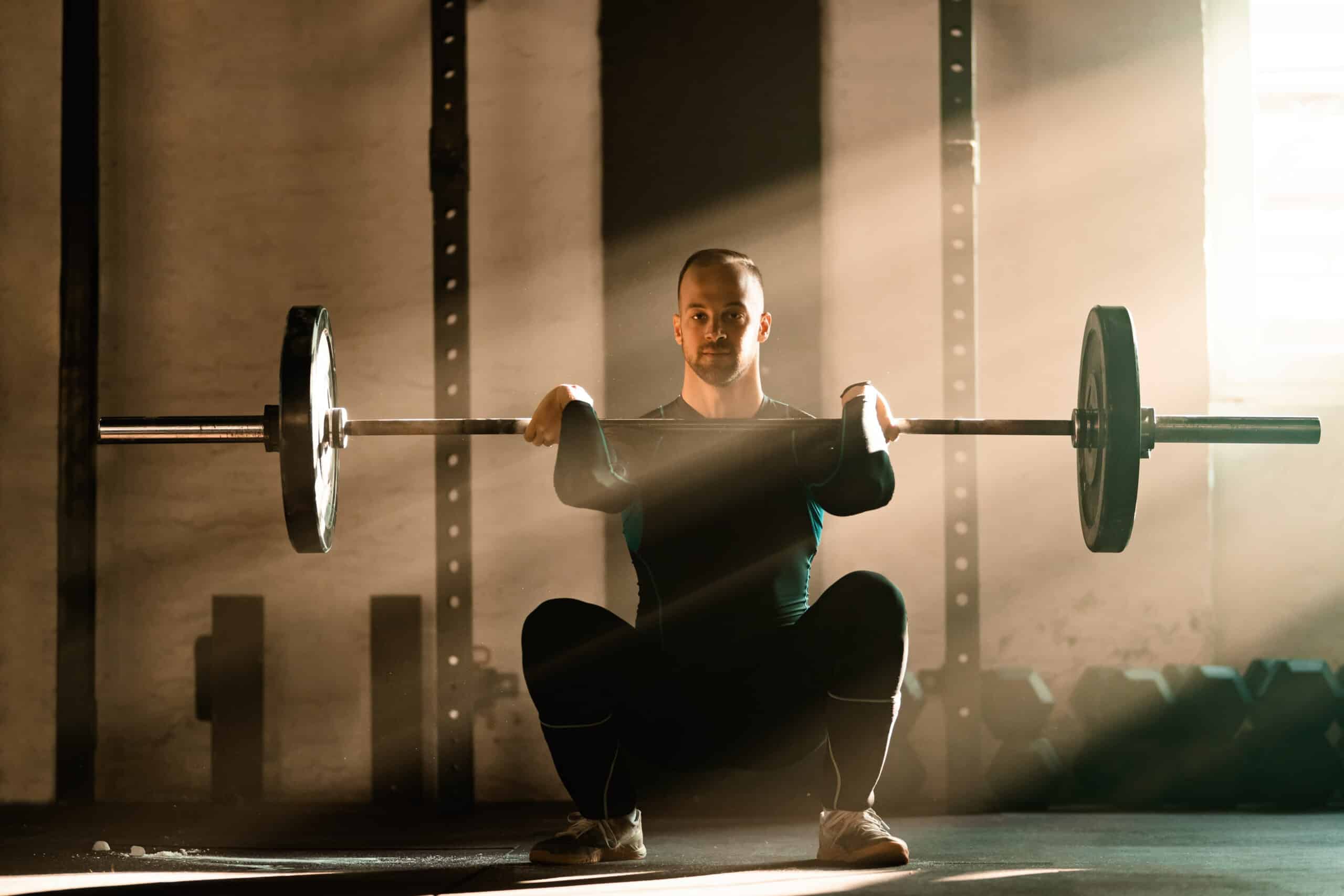Squats should be a staple in every gym goer’s training plan. They are an ideal lower body exercise that can also work your core and other other muscle groups when performed correctly. There are many squat variations that you can try, each has their own benefits. Whether you are a beginner squatter or seasoned veteran, here are some of the squat variations to add to your routine.
5 Beginner to Advanced Squat Variations
1. Prisoner Squat
The prisoner squat is one of the simplest squat variations because it just uses your bodyweight. It is a great staple exercise for anyone to add to their regime, especially for beginners starting out. It is a lower body workout that not only strengthens your legs and glutes but can also work your core and shoulders.
Prisoner squats can also be done anywhere as you are only using your bodyweight! So you can fit them in during an ad break, or even at work. To perform a prisoner squat, make sure that your feet are planted firmly on the ground, hip-width apart. Your weight should be distributed evenly between them. Engage your core as you pull your shoulder blades slightly together.
Bend at the knees and lower yourself to the ground as if you are sitting on a chair. Remember to keep your torso upright. Keep lowering yourself until you are parallel to the ground, and if you can, go beyond that parallel line. Make sure that your knees do not drop inward as you do so; keep your knees rotated out. Stand up again by straightening your legs. And repeat. To make the standard prisoner squat more challenging, try holding the lower squat position and pulsing.
2. Goblet Squat
Another great squat variation is the goblet squat. This is similar to the prisoner squat but with added weight. You can use a dumbbell or kettlebell.
Hold the dumbbell or kettlebell up close to your chest as you squat. If you are starting out, start with a lighter weight, just to get used to the movement. Then keep increasing your weight as you progress. This squat will not only work that lower body but it can also work the core. It can also help prepare you for the front squat, which we will talk about soon!
3. High Bar Back Squat
This is the classic squat that people tend to gravitate towards. It is a comfortable place for people to hold the bar.This squat variation uses a barbell that is placed across your back on the trapezius muscles on top of the shoulders.
During the high bar back squat, make sure that the bar remains aligned with your midfoot. Your torso needs to remain as upright as possible to keep the weight from shifting forward. The high bar back squat is a squat variation that places emphasis on the quadriceps (front thigh muscles) and glutes. There is less reliance on the hamstrings. However, compared to other squat variations, such as the low bar squat, you won’t be able to squat as heavy.
If you want to make it harder, then try pausing for a couple of seconds at the bottom of the squat before coming up. The high bar squat is also great to help those who do weightlifting (the snatch and clean & jerk).
4. Low Bar Back Squat
Another squat variation is the low bar back squat. This squat places the barbell on lower on the upper back than the high bar back squat position—on the posterior deltoid. It is only a slight shift in position of the bar but it does result in different body parts being used in the movement.
In this position, your torso should lean forward even more. This offloads some of the weight on your back and to help keep you balanced. It also means that you will be able to squat heavier than the high bar squat. You have less range of motion because your torso will be more horizontal.
Your feet should be wider than that of a high bar squat, as well as your hands. To help lean your chest forward, your hips will also be pushed back. This version of the squat works the hamstrings and glutes. It also places more emphasis on the posterior chain. If you have knee problems, then the low bar is a good option as there is less stress on the knees.
5. Front Squat
The front squat works the anterior aspect of your body, emphasizing the quads and core. It uses the barbell but instead of placing it on your back, it is placed in front of you, resting on your front deltoids and collarbone. Your arms can be in two different positions:
Classic Grip: Place your right-hand fingertips under the bar on your right side, and do the same for the left. The number of fingertips you use to hold the bar depends on your preference. Keep your elbows up so your upper arms are parallel to the ground. This position can be difficult for those with limited wrist mobility.
Cross Grip: Your right hand can hold the bar on your left shoulder and vice versa. Your arms will be in a cross position, touching opposite hands to shoulders. If you have limited wrist mobility, you may prefer this grip.
As you squat, try to keep your elbows in and up and your knees out. The squat is a really great move to include in your training. With these squat variations ranging from beginner to advanced, you can pick and choose which ones suit your fitness goal and level so you are not missing out on these great benefits.
Stay Strong Together: Track Your Exercises with Jefit
Jefit is a workout log app that has an extensive library. With the ability to mix and match your training, including different kinds of squats, you can really maximize your gym workouts and make the most of them. These are just 5 of the many types of squats you can do—check out Jefit’s exercise library here to find more!
Have you tried any of these different kinds of squats? Which ones do you like? Let us know in the Jefit community, we would love to know!
- Want to Build Strong Arms? Try These Jefit Exercises - May 3, 2024
- 3 Reasons Better Quality of Sleep Improves Health & Fitness - May 1, 2024
- A Brief Review of the Benefits of Intermittent Fasting - April 29, 2024

